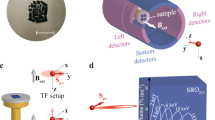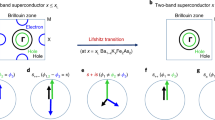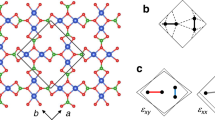Abstract
Superconductivity — one of the best understood many-body problems in physics — has again become a challenge following the discovery of unconventional superconducting materials: these include heavy-fermion1, organic2 and the high-transition-temperature copper oxide3 superconductors. In conventional superconductors, the electrons form superconducting Cooper pairs in a spin-singlet state, which has zero total spin (S = 0). In principle, Cooper pairs can also form in a spin-triplet state (S = 1), analogous to the spin-triplet ‘p-wave’ state of paired neutral fermions in superfluid 3He (ref. 4). At present, the heavy-fermion compound UPt3 is the only known spin-triplet superconductor5,6, although the layered oxide superconductor Sr2RuO4 (ref. 7) is believed, on theoretical grounds8, to be a promising candidate. The most direct means of identifying the spin state of Cooper pairs is from measurements of their spin susceptibility, which can be determined by the Knight shift (as probed by nuclear magnetic resonance (NMR)). Here we report Knight-shift measurements of Sr2RuO2 using 17O NMR. Our results show no change in spin susceptibility on passing through the superconducting transition temperature, which provides the definitive identification of Sr2RuO4 as a spin-triplet superconductor.
This is a preview of subscription content, access via your institution
Access options
Subscribe to this journal
Receive 51 print issues and online access
$199.00 per year
only $3.90 per issue
Buy this article
- Purchase on Springer Link
- Instant access to full article PDF
Prices may be subject to local taxes which are calculated during checkout



Similar content being viewed by others
References
MacLaughlin, D. E. et al. Nuclear magnetic resonance and heavy-fermion superconductivity in (U,Th)Be13. Phys. Rev. Lett. 53, 1833–1836 (1984).
Mayaffre, H. et al. Superconducting state of κ-(ET)2Cu[N(CN)2]Br studied by 13C NMR: evidence for vortex-core-induced nuclear relaxation and unconventional pairing. Phys. Rev. Lett. 75, 4122–4125 (1995).
Kitaoka, Y. et al. Nuclear relaxation and Knight shift studies of copper in YBa2Cu3O7−y. J. Phys. Soc. Jpn 57, 30–33 (1988).
Lee, D. M. The extraordinary phase of liquid 3He. Rev. Mod. Phys. 69, 645–665 (1997).
Tou, H. et al. Odd-parity superconductivity with parallel spin pairing in UPt3: evidence from 195Pt Knight shift study. Phys. Rev. Lett. 77, 1374–1377 (1996).
Tou, H. et al. Nonunitary spin-triplet superconductivity in UPt3: evidence from 195Pt Knight shift study. Phys. Rev. Lett. 80, 3129–3132 (1996).
Maeno, Y. et al. Superconductivity in a layered perovskite without copper: Sr2RuO4. Nature 372, 532–534 (1994).
Rice, T. M. & Sigrist, M. Sr2RuO4: an electronic analogue of 3He? J. Phys. Condens. Matter 7, L643–L648 (1995).
Hebel, L. C. & Slichter, C. P. Nuclear spin relaxation in normal and superconducting aluminum. Phys. Rev. 113, 1504–1519 (1959).
Ishida, K. et al. Anisotropic pairing in superconducting Sr2RuO4: Ru NMR and NQR studies. Phys. Rev. B 56, R505–R508 (1997).
Mackenzie, A. P. et al. Extremely strong dependence of superconductivity on disorder in Sr2RuO4. Phys. Rev. Lett. 80, 161–164 (1998).
Luke, G. M. et al. Time-reversal symmetry breaking superconductivity in Sr2RuO4. Nature 394, 558–561 (1998).
Yosida, K. Paramagnetic susceptibility in superconductors. Phys. Rev. 110, 769 (1958).
Barrett, S. E. et al. 63Cu Knight shift in the superconducting state of YBa2Cu3O7−δ. Phys. Rev. B 41, 6283–6296 (1990).
Ishida, K. et al. Cu NMR and NQR studies of impurities-doped YBa2(Cu1−xMx)3O7(M=Zn and Ni). J. Phys. Soc. Jpn 62, 2803–2818 (1993).
Oguchi, T. Electronic band structure of the superconductor Sr2RuO4. Phys. Rev. B 51, 1385–1388 (1995).
Maeno, Y. et al. Two dimensional Fermi liquid behavior of the superconductor Sr2RuO4. J. Phys. Soc. Jpn 66, 1405–1408 (1997).
Mazin, I. I. & Singh, D. J. Ferromagnetic spin fluctuation induced superconductivity in Sr2RuO4. Phys. Rev. Lett. 79, 733–736 (1997).
Kanoda, K. NMR relaxation rate in the superconducting state of the organic conductor, κ(BEDT-TTF)2Cu[N(CN)2]Br. Phys. Rev. B 54, 76–79 (1996).
Anderson, P. W. Knight shift in superconductors. Phys. Rev. Lett. 3, 325–356 (1959).
de Visser, A. et al. UPt3, heavy fermions and superconductivity. Physica B 147, 81–160 (1987).
Acknowledgements
We thank K. Miyake, O. Narikiyo, M. Sigrist, K. Yamada, G.-q. Zheng and H. Tou, for discussions and comments, and T. Ando for magnetization measurements. This work was supported by the Grants-in-Aid for COE Research from the Ministry of Education, Sport, Science and Culture of Japan. One of us (H.M.) was supported by JPSJ research fellowships for young scientists.
Author information
Authors and Affiliations
Corresponding author
Supplementary Information
Rights and permissions
About this article
Cite this article
Ishida, K., Mukuda, H., Kitaoka, Y. et al. Spin-triplet superconductivity in Sr2RuO4 identified by 17O Knight shift. Nature 396, 658–660 (1998). https://doi.org/10.1038/25315
Received:
Accepted:
Issue Date:
DOI: https://doi.org/10.1038/25315
This article is cited by
-
Unconventional superconductivity in Cr-based compound Pr3Cr10−xN11
npj Quantum Materials (2024)
-
Unusual Sequence of the Critical Magnetic Fields \(H_{c1}\), \(H_{c2}\), and \(H_{c}\) in Multicomponent Superconductors
Journal of Superconductivity and Novel Magnetism (2024)
-
The search for spontaneous edge currents in Sr2RuO4 mesa structures with controlled geometrical shapes
Scientific Reports (2023)
-
Distinct spin and orbital dynamics in Sr2RuO4
Nature Communications (2023)
-
Two-dimensional superconductors with intrinsic p-wave pairing or nontrivial band topology
Science China Physics, Mechanics & Astronomy (2023)
Comments
By submitting a comment you agree to abide by our Terms and Community Guidelines. If you find something abusive or that does not comply with our terms or guidelines please flag it as inappropriate.



